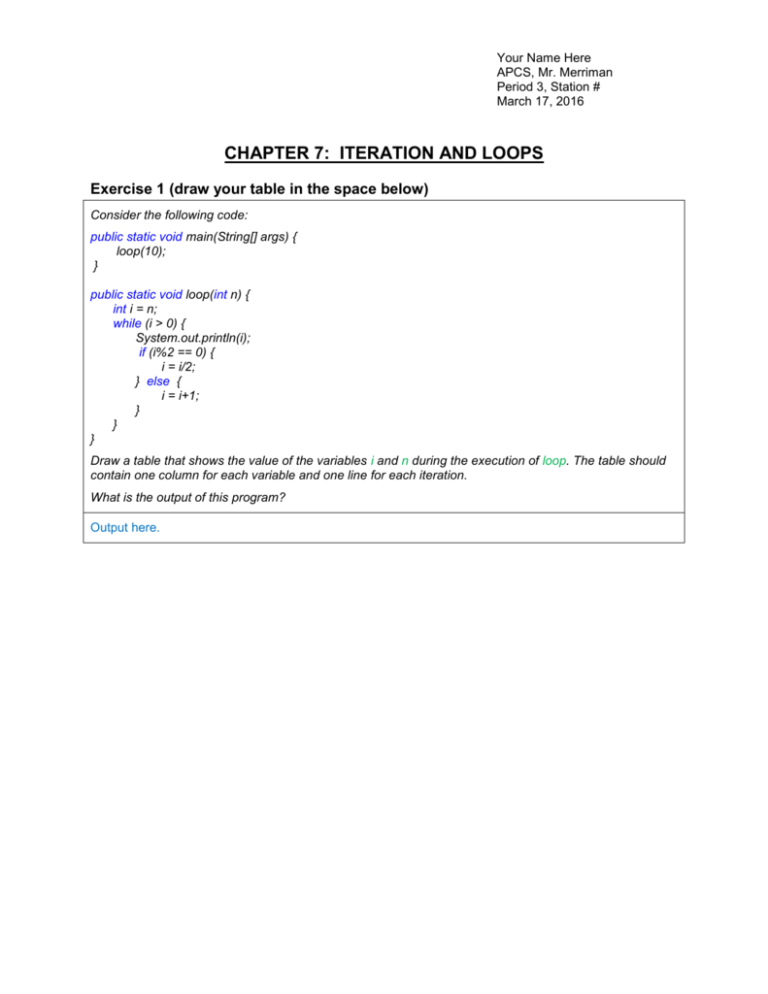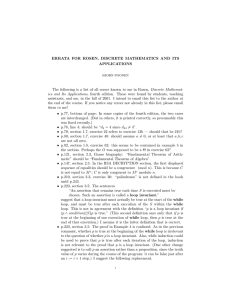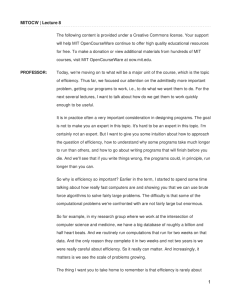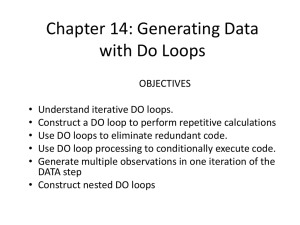Java Iteration & Loops Exercises
advertisement

Your Name Here
APCS, Mr. Merriman
Period 3, Station #
March 17, 2016
CHAPTER 7: ITERATION AND LOOPS
Exercise 1 (draw your table in the space below)
Consider the following code:
public static void main(String[] args) {
loop(10);
}
public static void loop(int n) {
int i = n;
while (i > 0) {
System.out.println(i);
if (i%2 == 0) {
i = i/2;
} else {
i = i+1;
}
}
}
1. Draw a table that shows the value of the variables i and n during the execution of loop. The table should
contain one column for each variable and one line for each iteration.
2. What is the output of this program?
Output here.
Exercise 2
Let’s say you are given a number, a, and you want to find its square root. One way to do that is to start
with a very rough guess about the answer, x0, and then improve the guess using the following formula:
x1 =(x0 + a/x0) / 2
For example, if we want to find the square root of 9, and we start with x 0 = 6, then x1 =(6 + 9/6) /2 = 15/4 =
3.75, which is closer.
We can repeat the procedure, using x1 to calculate x2, and so on. In this case, x2 = 3.075 and x3 =
3.00091. So that is converging very quickly on the right answer(which is 3).
Write a method called squareRoot that takes a double as a parameter and that returns an approximation
of the square root of the parameter, using this technique. You may not use Math.sqrt.
As your initial guess, you should use a/2. Your method should iterate until it gets two consecutive
estimates that differ by less than 0.0001; in other words, until the absolute value of xn − xn−1 is less than
0.0001. You can use Math.abs to calculate the absolute value.
squareRoot method here
Exercise 3
In Exercise 9 we wrote a recursive version of power, which takes a double x and an integer n and returns
xn. Now write an iterative method to perform the same calculation.
Iterative version of power method here.
Exercise 4
Section 6.8 presents a recursive method that computes the factorial function. Write an iterative version of
factorial.
Iterative version of factorial method here.
Exercise 5
One way to calculate ex is to use the infinite series expansion
ex = 1 + x + x2 / 2! + x3 / 3! + x4 / 4! + ...
If the loop variable is named i, then the ith term is xi / i!.
1. Write a method called myexp that adds up the first n terms of this series. You can use the
factorial method from Section 6.8 or your iterative version from the previous exercise.
2. You can make this method much more efficient if you realize that in each iteration the numerator
of the term is the same as its predecessor multiplied by x and the denominator is the same as its
predecessor multiplied by i. Use this observation to eliminate the use of Math.pow and factorial,
and check that you still get the same result.
First myexp method here
Second, more efficient, myexp method here
3. Write a method called check that takes a single parameter, x, and that prints the values of x,
Math.exp(x) and myexp(x) for various values of x. The output should look something like:
1.0
2.708333333333333
2.718281828459045
HINT: you can use the String "\t" to print a tab character between columns of a table.
4. Vary the number of terms in the series (the second argument that check sends to myexp) and
see the effect on the accuracy of the result. Adjust this value until the estimated value agrees with
the “correct” answer when x is 1.
Check method here
Invoke check with x=5 and show output here
5. Write a loop in main that invokes check with the values 0.1, 1.0, 10.0, and 100.0.
Main method here, with loop
show output here
How does the accuracy of the result vary as x varies? Compare the number of digits of
agreement rather than the difference between the actual and estimated values.
Answer here
6. Add a loop in main that checks myexp with the values -0.1, -1.0, -10.0, and -100.0.
Show loop here, with iterative variable
show output here
Comment on the accuracy.
Comment here
Exercise 6
One way to evaluate exp(−x2) is to use the infinite series expansion
exp(−x2) = 1 − x2 + x4/2 − x6/6 + …
In other words, we need to add up a series of terms where the ith term is equal to (−1) i x2i / i!. Write a
method named gauss that takes x and n as arguments and that returns the sum of the first n terms of the
series. You should not use factorial or pow.
gauss method here










